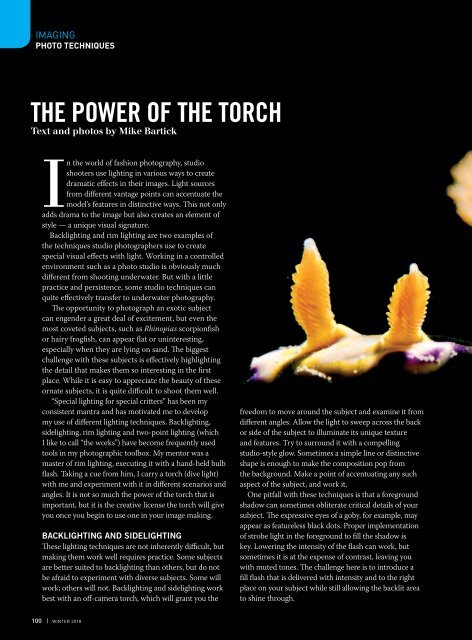AD 2018 Q1
Alert Diver is the dive industry’s leading publication. Featuring DAN’s core content of dive safety, research, education and medical information, each issue is a must-read reference, archived and shared by passionate scuba enthusiasts. In addition, Alert Diver showcases fascinating dive destinations and marine environmental topics through images from the world’s greatest underwater photographers and stories from the most experienced and eloquent dive journalists in the business.
Alert Diver is the dive industry’s leading publication. Featuring DAN’s core content of dive safety, research, education and medical information, each issue is a must-read reference, archived and shared by passionate scuba enthusiasts. In addition, Alert Diver showcases fascinating dive destinations and marine environmental topics through images from the world’s greatest underwater photographers and stories from the most experienced and eloquent dive journalists in the business.
Create successful ePaper yourself
Turn your PDF publications into a flip-book with our unique Google optimized e-Paper software.
IMAGING<br />
PHOTO TECHNIQUES<br />
THE POWER OF THE TORCH<br />
Text and photos by Mike Bartick<br />
In the world of fashion photography, studio<br />
shooters use lighting in various ways to create<br />
dramatic effects in their images. Light sources<br />
from different vantage points can accentuate the<br />
model’s features in distinctive ways. This not only<br />
adds drama to the image but also creates an element of<br />
style — a unique visual signature.<br />
Backlighting and rim lighting are two examples of<br />
the techniques studio photographers use to create<br />
special visual effects with light. Working in a controlled<br />
environment such as a photo studio is obviously much<br />
different from shooting underwater. But with a little<br />
practice and persistence, some studio techniques can<br />
quite effectively transfer to underwater photography.<br />
The opportunity to photograph an exotic subject<br />
can engender a great deal of excitement, but even the<br />
most coveted subjects, such as Rhinopias scorpionfish<br />
or hairy frogfish, can appear flat or uninteresting,<br />
especially when they are lying on sand. The biggest<br />
challenge with these subjects is effectively highlighting<br />
the detail that makes them so interesting in the first<br />
place. While it is easy to appreciate the beauty of these<br />
ornate subjects, it is quite difficult to shoot them well.<br />
“Special lighting for special critters” has been my<br />
consistent mantra and has motivated me to develop<br />
my use of different lighting techniques. Backlighting,<br />
sidelighting, rim lighting and two-point lighting (which<br />
I like to call “the works”) have become frequently used<br />
tools in my photographic toolbox. My mentor was a<br />
master of rim lighting, executing it with a hand-held bulb<br />
flash. Taking a cue from him, I carry a torch (dive light)<br />
with me and experiment with it in different scenarios and<br />
angles. It is not so much the power of the torch that is<br />
important, but it is the creative license the torch will give<br />
you once you begin to use one in your image making.<br />
BACKLIGHTING AND SIDELIGHTING<br />
These lighting techniques are not inherently difficult, but<br />
making them work well requires practice. Some subjects<br />
are better suited to backlighting than others, but do not<br />
be afraid to experiment with diverse subjects. Some will<br />
work; others will not. Backlighting and sidelighting work<br />
best with an off-camera torch, which will grant you the<br />
freedom to move around the subject and examine it from<br />
different angles. Allow the light to sweep across the back<br />
or side of the subject to illuminate its unique texture<br />
and features. Try to surround it with a compelling<br />
studio-style glow. Sometimes a simple line or distinctive<br />
shape is enough to make the composition pop from<br />
the background. Make a point of accentuating any such<br />
aspect of the subject, and work it.<br />
One pitfall with these techniques is that a foreground<br />
shadow can sometimes obliterate critical details of your<br />
subject. The expressive eyes of a goby, for example, may<br />
appear as featureless black dots. Proper implementation<br />
of strobe light in the foreground to fill the shadow is<br />
key. Lowering the intensity of the flash can work, but<br />
sometimes it is at the expense of contrast, leaving you<br />
with muted tones. The challenge here is to introduce a<br />
fill flash that is delivered with intensity and to the right<br />
place on your subject while still allowing the backlit area<br />
to shine through.<br />
100 | WINTER <strong>2018</strong>









